Transform your urban abode into a lush retreat with vertical window gardening, the perfect solution for enthusiasts keen on small space gardening. As city landscapes become more compact, vertical window gardening emerges as a strategic trend in urban gardening, offering a slice of nature without the sprawl. Discover inspiring window garden ideas that elevate not only your living space but also your well-being.
Whether you reside in a cozy apartment or a home where ground space is scarce, your windows present untapped potential for greenery and growth. By harnessing the vertical axis, you can cultivate an array of plants, from delicate flowers to nourishing vegetables, right outside your window. The vertical approach is not just pragmatic; it’s a dynamic canvas for your horticultural creativity.
Key Takeaways
- Vertical window gardening leverages unused vertical spaces, offering an innovative method for growing plants in urban settings.
- It is an ideal approach for small space gardening, allowing city dwellers to create personal green spaces without the need for additional square footage.
- Urban gardening techniques adapted to window spaces can result in a sustainable and pleasing living environment.
- Window garden ideas that employ vertical structures add elements of design and beauty to practical gardening efforts.
- Embracing vertical gardening can lead to an increase in biodiversity and improve air quality within your urban space.
- It encourages eco-conscious living by maximizing green areas in densely populated cities.
- Vertical window gardens are customizable, reflecting personal style and fitting into various architectural nuances.
Embracing Vertical Window Gardening in Urban Spaces
Amid the bustle of city life, apartment gardening provides a serene retreat for those seeking to cultivate their own slice of nature. However, gardening in limited space poses unique challenges, requiring innovative solutions. Vertical window gardening is an artful and practical approach to bringing verdant life to urban dwellings, regardless of the square footage constraints. By utilizing window gardening techniques, you can transform your apartment’s windows into lush, green panoramas that offer both aesthetic pleasure and potential for homegrown produce.
Creating a vertical garden begins with identifying the right structure for your space. Whether choosing sturdy window boxes, hanging containers, or trellises adhered to walls, the options are limitless. These structures provide the backbone for your vertical oasis, enabling you to grow a myriad of plant life outside your window pane.
- Handy window boxes for herbs and small plants
- Innovative pockets to house succulents and ferns
- Steadfast vertical lattices for climbing vines and flowers
For the city gardener, convenience is key. A variety of plants that require minimal care — such as drought-resistant succulents or hearty evergreens — can thrive in the vertical format and offer year-round vibrancy. Edible plants and herbs, such as basil, chives, and strawberries, can serve as both a visual feast and a culinary one, directly outside your living space.
| Plant Type | Container Type | Care Level | Light Requirements |
|---|---|---|---|
| Succulents | Wall pockets | Low | Bright, indirect light |
| Herbs (e.g., Basil) | Window boxes | Medium | Full sun |
| Small vegetables (e.g., Cherry Tomatoes) | Hanging baskets | Medium to High | Full sun |
| Flowering plants (e.g., Petunias) | Railing planters | Medium | Full sun to partial shade |
There’s a sense of fulfillment that comes with reaping the rewards of your own apartment gardening efforts. The vertical window garden is not only proof that beautiful and productive gardening can occur in small spaces, but it also stands as a testament to the adaptability of nature to fit our urban life.
The Fundamentals of Starting Your Window Garden
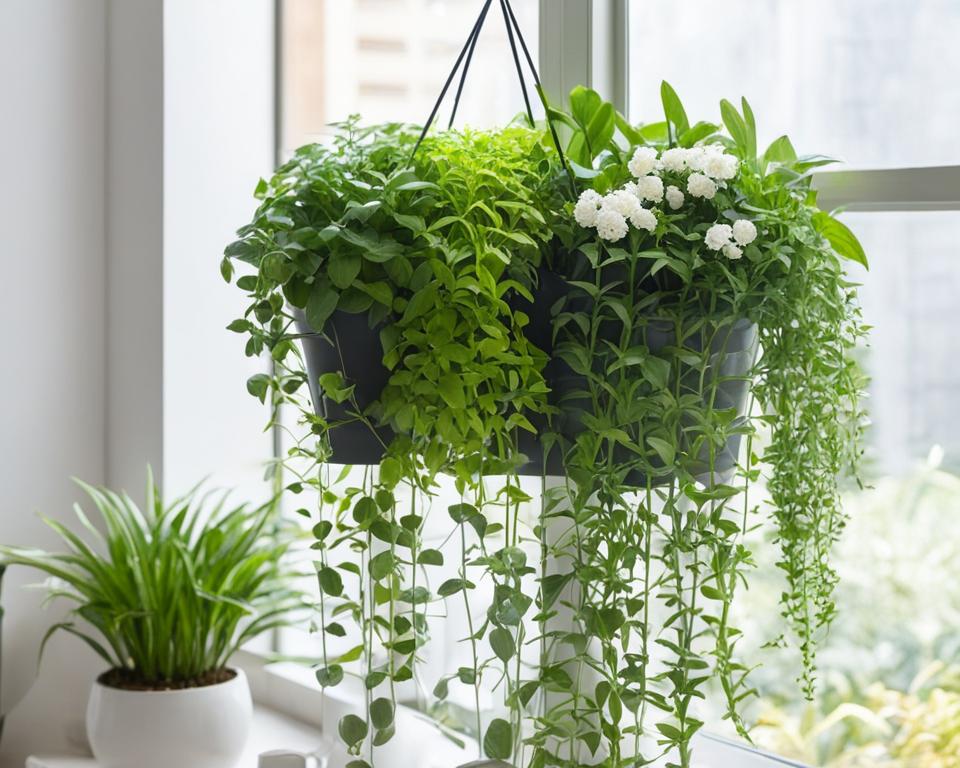
Embarking on the path to creating an indoor vertical garden necessitates starting with the right foundation. Choosing the proper containers for your vertical herb garden or window herb garden can make all the difference, setting the stage for a thriving, lush space. Below are practical tips to help you commence your indoor vertical gardening journey.
Selecting the Right Window Boxes
When choosing window boxes for your garden, consider factors like durability, size, and material to ensure they complement your home and lifestyle. The right window box should harmoniously fit with the aesthetics of your window while being robust enough to support the soil, water, and vegetation that will soon flourish within.
Here is a comparison of various window box materials and their attributes:
| Material | Durability | Weather Resistance | Aesthetic Appeal |
|---|---|---|---|
| Wood | High with proper treatment | Varies with treatment and wood type | Natural and classic |
| Plastic | Moderate to High | Highly Resistant | Modern and versatile |
| Metal | Very High | Depends on coating | Industrial and sleek |
| Fiberglass | High | Highly Resistant | Varies with designs |
| Terracotta | Moderate | Low | Timeless and traditional |
Significance of Proper Installation
The pursuit of an appealing and fruitful indoor garden hinges on secure installation. It isn’t enough for a window box to look the part; it must be anchored safely to prevent mishaps and ensure it remains an asset rather than a liability. Following the manufacturer’s guidelines for installation will provide peace of mind and lay the groundwork for your garden to prosper.
Consider the following installation tips:
- Use sturdy brackets and fasteners designed for your specific window frame material.
- Check the load-bearing capacity to ensure safety and durability.
- Regularly inspect the installation to address any wear or damage promptly.
With these considerations in mind, you are well on your way to cultivating a picturesque window herb garden that infuses your indoor space with a hint of nature’s serenity and an immediate connection to your culinary creations.
Choosing Plants for Your Window Herb Garden
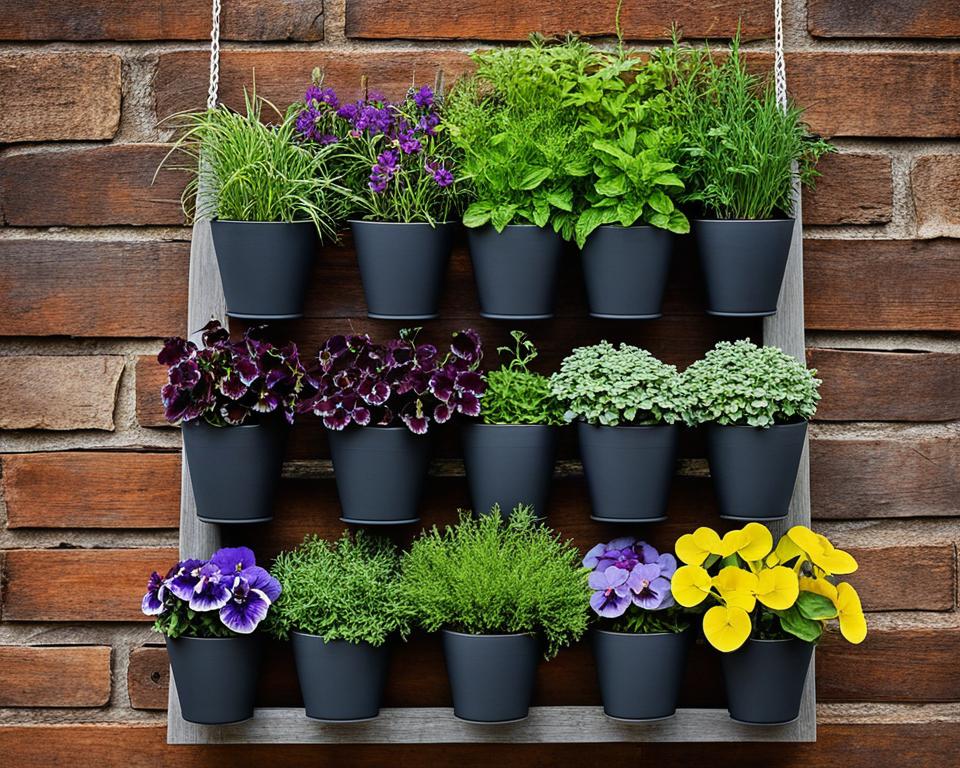
When designing your vertical herb garden, the key to creating a thriving green space is plant selection. Ideal candidates for your window herb garden are those that adapt well to less soil and can flourish in various light conditions typically found by windows. Let’s look at which plants can bring flavor to your kitchen while also enhancing the aesthetics of your home.
Selecting the Right Herbs: Consider starting with culinary staples such as basil, parsley, and rosemary—herbs that do not require deep roots and can handle the fluctuating temperatures of an urban environment. For visual interest and additional taste, add chives, thyme, and mint to your collection. They are not only practical, but they will fill your garden with a variety of textures and aromas.
Adding Flowers and Foliage: Why not include some non-edible plants as well? Succulents are excellent options for their minimal space requirements and ease of care. If you’re looking for a pop of color, marigolds and pansies are both vibrant and compact enough to coexist with your herbs without outcompeting them for space. Here’s a comparison of suggested plants for your window herb garden:
| Herbs | Characteristics | Flowers & Foliage | Characteristics |
|---|---|---|---|
| Basil | Requires warm conditions and plenty of sunlight | Marigolds | Colorful and can repel garden pests |
| Parsley | Biennial plant, prefers part sun to full shade | Pansies | Wide color variety and cool-weather tolerant |
| Rosemary | Tolerates hot, sunny environments well | Succulents | Diverse forms with minimal water needs |
| Mint | Spreads easily, best grown in a contained space | – | – |
| Chives | Hardy with a delicate onion flavor | – | – |
| Thyme | Low maintenance and drought-resistant | – | – |
By selecting the right mix, not only will you benefit from having a fragrant, edible vertical herb garden right outside your window, but your window herb garden will be a source of visual delight, year-round. Take the time to assess your space and choose plants that will thrive in your unique environment.
Vertical Gardening Techniques for Small Spaces
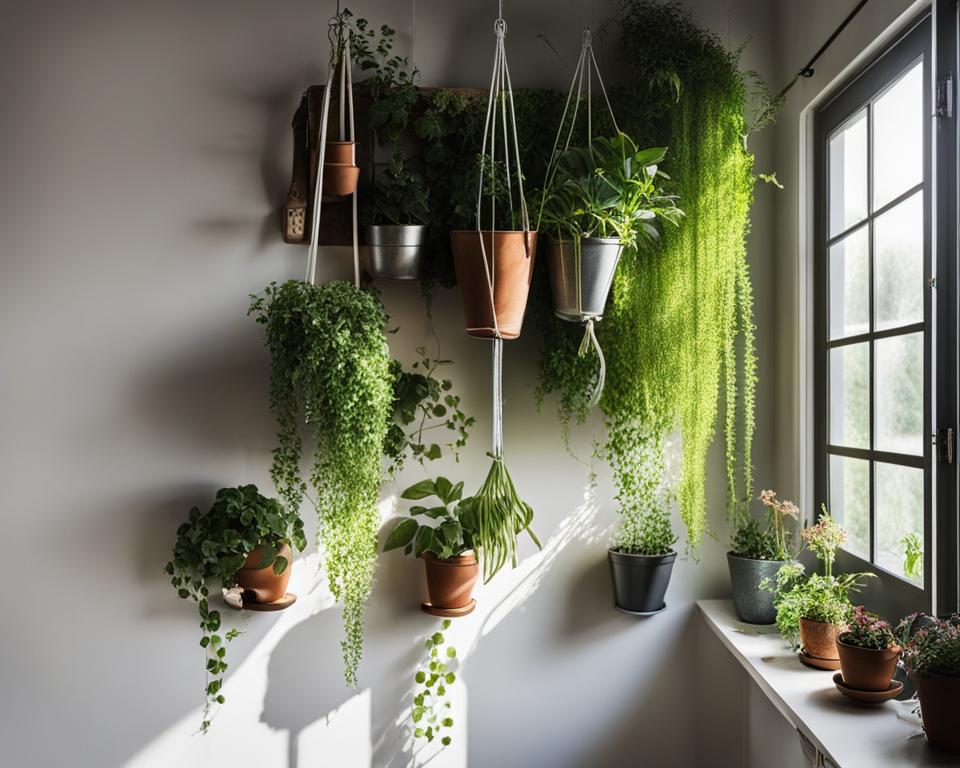
Transforming your limited outdoor real estate into a vibrant oasis is more than possible with inventive vertical window gardening solutions tailored for small spaces. Engage with exciting window garden ideas that repurpose everyday items into living art, contributing to sustainable practices while cultivating your personal patch of green.
Innovative Uses of Wall Planters
Envision your walls transforming into a lush tapestry of greenery, where wall planters become the canvas for your window garden ideas. Vertical window gardening harnesses unused vertical planes by introducing a mix of flora—be it vibrant flowers, lush ferns or culinary herbs. Find inventive containers that reflect your personal style to house a variety of plants, creating a stunning visual that doubles as your private urban retreat.
Repurposing Gutters into Green Space
Imagine rows of old gutters, once whisking away rain, now serving a new purpose as a cornerstone of small space gardening. Each gutter, fixed to a sunny wall, cradles a series of plants, creating a tiered effect rich with leafy greens or succulents. Not only does this method add layers of beauty to your vertical gardens, it’s a testament to sustainable living and resourcefulness.
Creative Bottle Garden Ideas
In the spirit of eco-conscious gardening, plastic bottles find new life as compact planters within your vertical garden. This family-friendly project encourages recycling and can become an engaging way to teach children about growing plants and environmental stewardship. With each bottle-turned-planter dangling gracefully, you curate a cascading window garden that’s both functional and educational.
Whether you’re an apartment dweller or simply seeking to maximize the potential of a petite patio, these vertical window gardening techniques exemplify how you can bloom where you’re planted—even when space is at a premium.
Enhancing Your Home with Edible Vertical Gardens
Imagine harvesting fresh herbs as you cook or plucking ripe strawberries directly from the vine, all without leaving the comfort of your home. This idyllic scenario is not just a dream—it’s the practical beauty of creating a vertical herb garden right in your apartment. The perks of apartment gardening are many; not only do you get to enjoy the visual appeal of lush greenery, but you also get the bonus of homegrown produce.
Whether you have a small balcony or just a sunny window, a window herb garden can fit into your space with ease. The concept of vertical gardening, which maximizes vertical space, is especially suited for those with limited ground area. Here’s how you can get started:
- Identify a sunny spot in your apartment, ideally a window that gets several hours of sunlight daily.
- Choose vertical planting systems like hanging pots, wall-mounted planters, or stackable growing containers.
- Select herbs and edible plants that grow well in confined spaces and match your culinary preferences.
For those looking to dive into the details, consider the following table with popular plants for your edible vertical garden:
| Herb/Plant | Light Requirements | Watering Needs | Harvest Tips |
|---|---|---|---|
| Basil | Full Sun | Keep soil moist | Pinch off leaves as needed |
| Parsley | Full Sun to Part Shade | Water regularly | Harvest outer leaves |
| Rosemary | Full Sun | Allow soil to dry between watering | Trim sprigs as desired |
| Strawberries | Full Sun | Keep soil evenly moist | Pick when fully red |
The transition from a garden to your table is seamless when you nurture a vertical garden. It encourages a sustainable lifestyle, cutting down on the food miles associated with store-bought greens and herbs. Beyond its ecological benefits, the presence of nature at home can improve air quality and boost your mood, making apartment gardening a holistic addition to your lifestyle.
As you can see, incorporating an edible vertical herb garden into your home is not only a practical way to grow your own food, but it also provides numerous benefits, from aesthetic enhancements to healthful living. Get creative and start planning your window herb garden today.
Vertical Window Gardening with Trellises
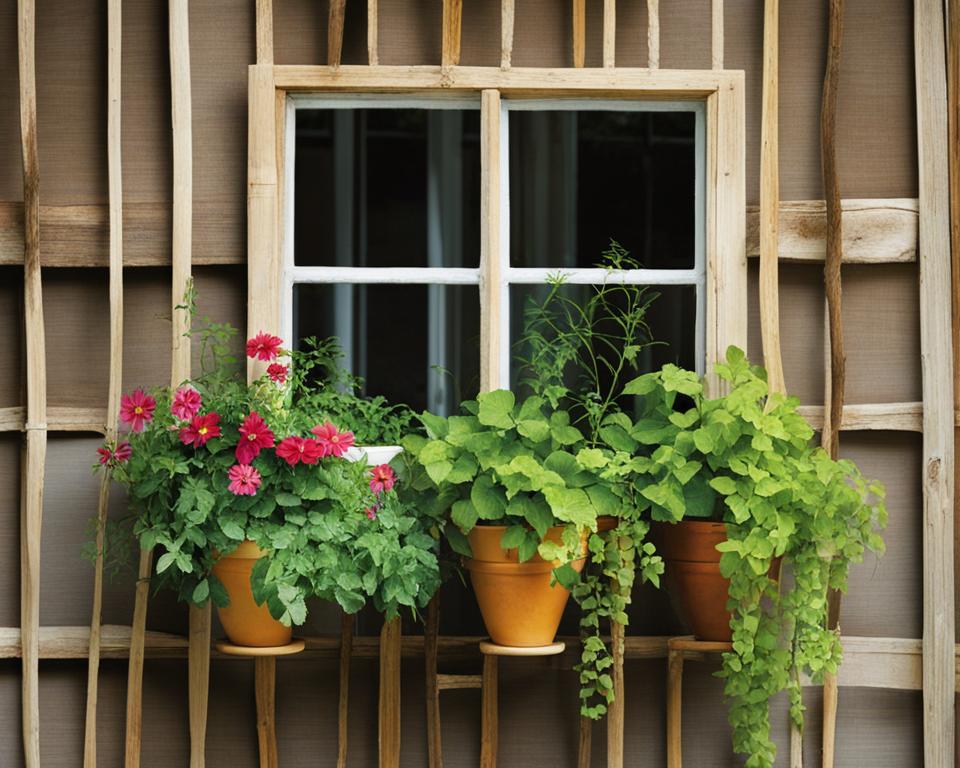
When your gardening dreams are bigger than your space allows, trellises provide an elegant solution to maximize your window gardening potential. Integrating a trellis into your small-scale garden empowers climbing plants to ascend towards the sun, creating a living tapestry that bestows beauty and bounty within arm’s reach. As a passionate urban gardener, you’ll discover that trellises are a cornerstone for gardening in limited space.
Selecting the Perfect Trellis
Choosing the right trellis is like picking out a frame for a masterpiece—it should be both strong and stylish, holding your plants aloft with ease. Trellises come in an array of materials, each with their own merits. Let’s dive into what makes a sturdy trellis that won’t just support your plants, but will stand as a statement piece all on its own.
Metal Trellises: Ideal for heavy climbers, giving a modern touch.
Bamboo Trellises: Lightweight and eco-friendly, perfect for delicate vines.
Wooden Trellises: Rustic charm that can support a variety of climbing plants.
Supporting Climbing Plants
Your window garden’s success hinges not just on the trellis you choose, but also on proper pairing with climbing plants. These vertical aspirants need a sturdy partner as they reach new heights. Ensuring that your trellis suits their growing habits is essential for a lush, vertical display that thrives in spite of spatial confines.
| Plant Type | Best Trellis Material | Maintenance Tips | Additional Benefits |
|---|---|---|---|
| Clematis | Wood | Regular pruning to encourage flowering | Brilliant blooms for aesthetic appeal |
| English Ivy | Metal | Keep under control to prevent overgrowth | Evergreen foliage for year-round greenery |
| Morning Glory | Bamboo | Tie vines gently to support climbing | Vibrant flowers for a pop of color |
| Tomatoes | Metal or sturdy wood | Support fruit-laden branches to avoid breakage | Edible rewards that heighten the joy of window gardening techniques |
As you venture into the realm of verticality, your choices in trellises and climbing plants, matched with savvy window gardening techniques, can transform even a modest area into a verdant vertical garden zone.
The Charm of Living Wall Gardens
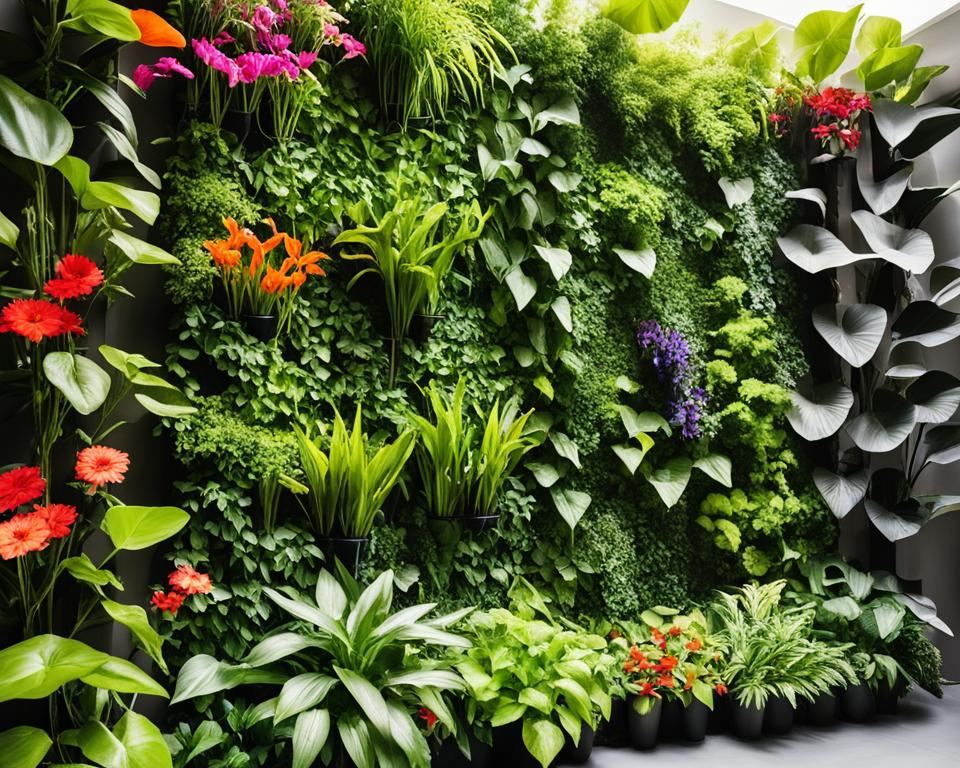
As you explore the realm of vertical window gardening, a compelling and artistic option presents itself: living wall gardens. These gardens offer a verdant tapestry of greenery that climbs and flourishes against your walls, turning ordinary spaces into dynamic ecosystems. They don’t just save space; they create an enchanting ambience that transforms the aesthetics of any interior. Ideal for indoor vertical gardening, living walls deliver both visual beauty and practical plant cultivation.
Planting Choices for Living Walls
Choosing plants for your living wall involves understanding the specific needs of each species and how they adapt to vertical growth. Succulents are a popular choice; they thrive in these setups and require minimal maintenance. Ferns, with their lush foliage, bring an element of softness and depth, while flowering vines introduce color and diversity, enhancing the wall’s texture. It’s crucial to consider light exposure, watering needs, and growth patterns to foster a flourishing living wall.
Structural Considerations for Living Walls
The infrastructure supporting your living wall is just as important as the botanical components. The backing material should be sturdy enough to hold the combined weight of soil, plants, and moisture. Systems such as wooden pallets or modular fabric pockets can be customized to fit your room’s dimensions. Ensuring adequate drainage and access for maintenance are also key components of a structurally sound living wall that enlivens your indoor space.
In implementing these vertical ecosystems, you not only enhance the visual appeal of your home but also benefit from the purifying effects of indoor plants. A thriving living wall is a conversation starter, an oxygen haven, and a testament to the inventive applications of vertical window gardening in the contemporary urban habitat.
Maintenance Practices for a Flourishing Garden
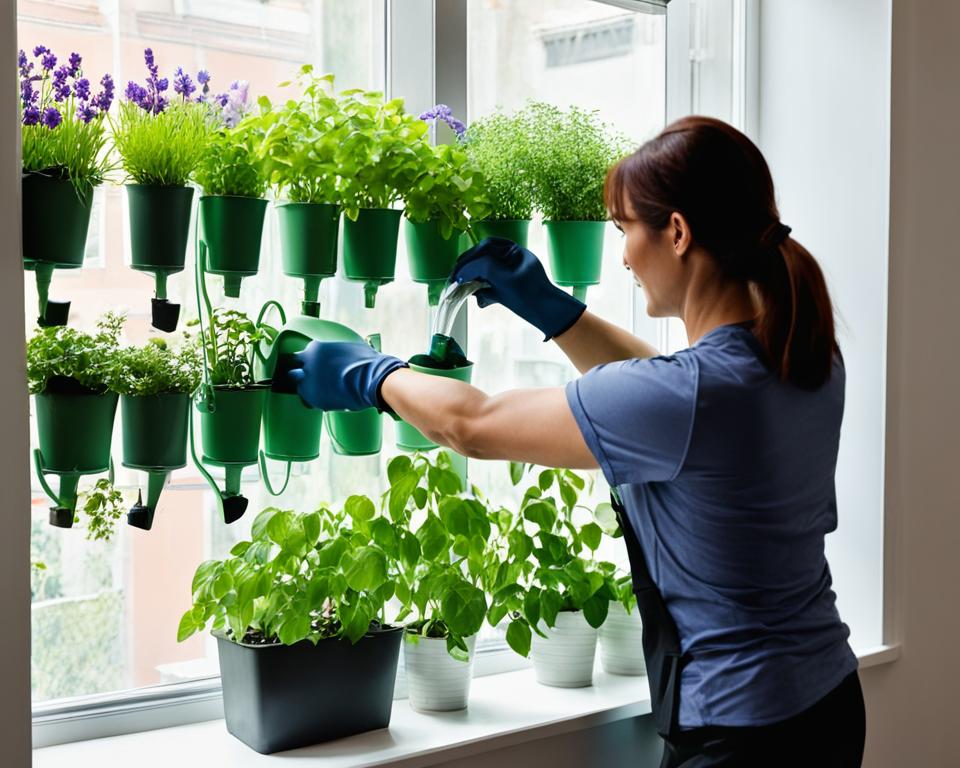
To ensure your vertical window garden thrives, mastering a few window gardening techniques is essential. One of the most critical aspects of vertical window gardening maintenance is monitoring and managing the health of your plants. This section will guide you through the key practices you need to incorporate to maintain a luscious and productive garden throughout the seasons.
Regular Pruning: To keep your plants healthy and your garden looking tidy, regular pruning is necessary. It helps to control growth, remove dead or diseased foliage, and encourage the production of flowers and fruits.
Watering: Vertical gardens often require careful attention to watering, as their elevated position can lead to quicker drying. You’ll want to establish a consistent watering schedule that keeps plant roots sufficiently moist without over-saturating them.
Fertilization: Just like any garden, your vertical green space occasionally needs a boost of nutrients. Depending on what plants you’re nurturing, a periodic application of fertilizer will keep them vigorous and productive.
| Task | Frequency | Notes |
|---|---|---|
| Pruning | Bi-weekly | Trim growth to maintain shape and remove any unhealthy parts. |
| Watering | 2-3 times per week | Adjust based on climate, plant type, and weather conditions. |
| Fertilizing | Monthly | Use a balanced, all-purpose fertilizer appropriate for your plants. |
| Disease Control | As needed | Monitor for signs of pests or disease and treat promptly. |
Remember, the best window garden is the one that’s well taken care of. Start with good habits and your vertical oasis will reward you with its beauty and bounty.
By following these guidelines, your vertical window garden will not only survive but will also become a vibrant feature of your home. Whether you’re growing herbs, flowers, or vegetables, maintenance is the key to success in any gardening endeavor. So roll up your sleeves and enjoy the rewarding process of nurturing your own slice of nature.
Design Tips for a Visually Appealing Vertical Garden
Creating an artistically compelling window garden is just like painting with plants; selecting the right shades and patterns is essential. To transform your high-rise haven or suburban bay window into an enchanting display, integrate a blend of plants that offer a contrast in texture, color, and growth habit. Here are some guidelines to ensure your small space gardening designs are as beautiful as they are functional.
Think of the visual impact of your garden throughout the seasons. Utilizing evergreens can provide a constant backdrop which allows seasonal plants to really stand out. Make use of hanging planters to add levels and depth, ensuring that each plant gets its moment in the sun. As you curate your garden, planning becomes paramount. How will the full-grown plants live together? And how will you access them for care and harvesting?
| Plant Type | Color | Texture | Growth Pattern | Seasonal Interest |
|---|---|---|---|---|
| Ferns | Deep green | Soft and feathery | Expansive and arching | Year-round foliage |
| Succulents | Varied hues | Smooth and waxy | Compact clustering | Year-round color, blooming in Spring/Summer |
| Annuals (e.g., Pansies) | Bright and varied | Silky | Ground-hugging and mounding | Spring to Fall color |
| Herbs (e.g., Basil) | Green to purple | Varied, some are smooth, others crinkly | Upright and bushy | Spring to Fall; edible |
As you mix and match these elements, don’t forget the importance of the container. Choosing the right pot can complement your plant selection, elevating the visual feast of your garden. For those who are aiming for a minimalistic approach, monochrome or terracotta pots can subtly underline the vibrancy of your plant choices without stealing the show.
Sunlight is your collaborator in the garden design process. Decipher the patterns of light and shadow in your space, and place your plants accordingly. For instance, taller plants should be positioned in such a way that they do not overshadow smaller, sun-loving species. Adequate sunlight exposure not only affects plant health but also how the colors of your garden are perceived throughout the day.
Lastly, remember that your window garden ideas are an ongoing project. Plants grow and change, and your garden should evolve with them. Occasional repositioning and “editing” will ensure that every plant continues to play its role in the harmonious ensemble, providing a constant source of joy from your very own living, breathing art piece.
Benefits of Combining Vertical and Raised Bed Gardening
As you delve into the realm of small space gardening and explore urban gardening techniques, the synthesis of vertical and raised bed gardens emerges as a revolutionary approach. This powerful combination not only maximizes your garden’s productivity but also serves as a delightful centerpiece of greenery that doesn’t compromise on limited urban spaces.
Maximizing Yield and Beauty
The strategic use of vertical structures, like trellises, in conjunction with raised beds elevates the visual appeal and functional yield of your garden. By creating different levels for plant growth, you achieve a stunning layered look while enjoying a bountiful harvest. Think of it as a living mosaic that provides both sustenance and sensory pleasure.
Utilizing Vertical Space Above Raised Beds
Vertical gardening components enrich the area above raised beds by offering a space-saving solution for climbing plants. By doing so, you cultivate an enchanting vertical landscape that grows in harmony with its horizontal counterpart, further enhancing the allure and productivity of your gardening space.
| Benefits | Raised Bed Gardening | Vertical Gardening |
|---|---|---|
| Ease of Access | Enhanced soil control and reduced strain on your back | Efficient use of vertical space for easy harvesting |
| Aesthetic Appeal | Clean, defined garden layout | Dynamic visual interest with layers of vegetation |
| Space Efficiency | Concentrated area for intensive planting | Expands planting space without spreading outwards |
| Plant Support | Provides a solid foundation for plants | Offers vertical support for climbers and vining plants |
| Garden Yield | Potential for higher soil fertility | Increases plantable surface area, resulting in larger yield |
By understanding the unique advantages each gardening method offers, you can create a symbiotic garden that is more productive, aesthetically pleasing, and ideal for your urban oasis. With this knowledge, begin envisioning your raised beds not just as containers for plant life, but as the foundation for a vertical garden masterpiece.
Conclusion
In the realm of urban gardening, vertical window gardening stands out as a beacon of innovation, promising lush greenery in the heart of concrete jungles. This approach is more than just a stylistic choice; it’s a testament to the creativity and resilience of city dwellers aspiring to integrate nature into their everyday spaces. The journey through window garden ideas and strategies detailed in this article offers a roadmap to constructing your personal oasis, turning even the smallest of windows into a canvas of vegetation.
Your endeavor to establish a vertical garden reflects a growing movement to reclaim and maximize sparse urban spaces. With a plethora of design options and plant varieties to choose from, your vertical window garden can cater not only to aesthetic preferences but also to functional needs, creating a sustainable source of herbs, vegetables, or simply, a revitalizing burst of green. The transformative effect of these gardens goes beyond visual appeal; they foster well-being and offer a serene retreat from the bustling city life.
Whether you’re an adept gardener with years of soil under your fingernails or a budding enthusiast with eagerness to cultivate, the world of vertical window gardening is ripe for exploration. With the right maintenance, a small investment of time and creativity can yield a kaleidoscope of flora. It’s your turn to sow the seeds of vertical growth, to watch your garden – and your passion for urban gardening – thrive against the skyline.
FAQ
What is vertical window gardening?
Vertical window gardening is a space-saving method of gardening where plants are grown vertically on the sides of windows or walls—ideal for urban residents or those with limited space who want to garden without a traditional, horizontal land plot.
Can I practice vertical gardening in any urban space?
Yes, vertical gardening can be adapted to almost any urban space, from tiny apartment balconies to large exterior walls. The key is to utilize vertical surfaces and structures effectively. It’s a smart solution for adding greenery to limited spaces.
Which window boxes should I select for my vertical garden?
Choose window boxes that are durable, properly sized to fit your space, and made of materials that can withstand the conditions they’ll be exposed to. Make sure they can bear the weight of soil, water, and plants without issue.
How important is proper installation of window boxes?
Proper installation is crucial for safety and the success of your vertical garden. It ensures that window boxes remain secure and plants receive the right support to grow and thrive.
What plants are best suited for a window herb garden?
Herbs that require less root space, such as basil, parsley, rosemary, and thyme, are ideal for window herb gardens. They tolerate the varied microclimates found near windows well and offer fresh ingredients for your cooking.
How can I implement vertical gardening in a small space?
Utilize innovative vertical gardening techniques like hanging wall planters, repurposed gutters, and bottle gardens to maximize your vertical space. These can be custom-fit to your area and allow for a range of plants to be grown.
What are some creative ideas for wall planters?
Wall planters can be fashioned from items like old wooden crates, metal tins, or fabric pockets. Arrange them in patterns on your wall for a decorative and functional growing space.
How can I make a green space using old gutters?
Repurpose old gutters by mounting them horizontally on a fence or wall, filling them with soil and plants. This method offers a unique and efficient way to garden in a limited space.
Can edible plants be grown in vertical gardens?
Absolutely! Edible plants like herbs, strawberries, and leafy greens are perfect for vertical gardens. They provide fresh ingredients, enhance the beauty of your home, and can thrive even in smaller spaces.
What should I look for when selecting a trellis?
Choose a trellis based on the types of climbing plants you want to grow, as well as the weight-bearing capacity and material that suits your garden aesthetic. Ensure that it is sturdy and matches the growing needs of your plants.
How do I support climbing plants in my vertical garden?
Use trellises, nets, or strings strategically placed so plants have something to latch onto as they grow. These structures enable plants to climb upwards and make use of vertical space.
What plants work well in a living wall garden?
Living walls can accommodate a variety of plants, from hardy succulents and ferns to vibrant flowering annuals and perennials. The key is to select plants that will thrive in the wall’s environmental conditions and alignment.
Are there any special structural considerations for creating a living wall?
Yes, it’s important to account for the wall’s ability to support the weight of plants, soil, and water. Ensure the structure is properly anchored and can handle drainage and irrigation needs without water damage.
What maintenance is required for a vertical window garden?
Regular maintenance, including proper watering, pruning, and fertilization, is necessary to keep your vertical garden flourishing. Special attention must be paid to plant health and to prevent overgrowth.
How can I design my vertical garden to be visually appealing?
Plan your garden with a variety of plant colors, textures, and growth patterns to create visual interest. Consider the plants’ sunlight needs and layer accordingly to ensure all plants thrive.
How do vertical and raised bed gardening work together?
Combining vertical structures with raised beds allows for increased productivity and aesthetic appeal in a garden. Vertical elements provide support, enabling plants to use airspace above the bed, while raised beds offer improved soil conditions and ergonomics.

